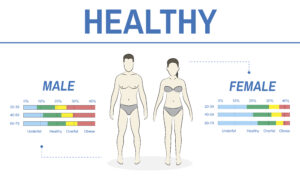When it comes to health, numbers often speak louder than words. One of the most widely used indicators of weight-related health risks is the Body Mass Index (BMI). For Singaporeans, understanding BMI ranges is even more critical because our national health guidelines differ from global standards.
Why does this matter? Because the Singapore obesity rate has been steadily climbing, and if left unaddressed, it can significantly affect quality of life, mobility, and long-term health. At Chiropractic Singapore, we believe that numbers like BMI don’t just tell a story about weight — they reveal deeper connections to lifestyle, posture, and even spinal health.
In this article, we’ll explore what BMI means and how understanding BMI ranges can help you take control of your health in a way that truly matters.
What is BMI?
BMI, or Body Mass Index, is a widely used screening tool that compares a person’s weight against their height to provide an estimate of body composition. The BMI formula is simple:
BMI = weight (kg) ÷ height² (m²)
This calculation categorises individuals into different weight groups — such as underweight, healthy weight, overweight, or obese.
Why does my BMI range matter?
Research shows that as BMI increases, so does the likelihood of developing conditions such as Type 2 diabetes, cardiovascular disease, hypertension, and joint or spinal problems. On the other hand, being underweight may also carry risks, including weakened immunity and reduced bone density.
The BMI Formula: A Simple Yet Powerful Tool
At first glance, the BMI formula seems almost too simple. But simplicity is its strength. By comparing weight and height, it provides an accessible indicator of whether your weight is appropriate for your body size.
For most people, calculating BMI is straightforward — but interpreting it correctly requires using the BMI ranges that apply locally. This is why using a BMI calculator Singapore version is more accurate than relying on global calculators.
Singapore BMI Ranges:
| Category | WHO BMI Ranges | Singapore BMI Ranges | Health Implications |
|---|---|---|---|
| Underweight | < 18.5 | < 18.5 | Risk of nutritional deficiencies, weakened immunity, and bone density loss. |
| Normal / Healthy | 18.5 – 24.9 | 18.5 – 22.9 | Optimal health, lowest risk of chronic illness. |
| Overweight (At-Risk) | 25.0 – 29.9 | 23.0 – 27.4 | Increased risk of diabetes, heart disease, hypertension, and spinal or joint strain. |
| Obese | ≥ 30 | ≥ 27.5 | High risk of chronic diseases, sleep disorders, musculoskeletal problems, and mobility issues. |
What is the healthy BMI range in Singapore?
In Singapore, the healthy BMI range is defined as 18.5 – 22.9. Staying within this range is linked with lower risks of chronic diseases, greater mobility, and improved energy levels.
But it’s not just about avoiding disease — having a healthy BMI also reduces strain on the joints and spine. Excess body weight can accelerate wear and tear on the spinal discs and joints, leading to back pain, stiffness, and reduced mobility.
At Chiropractic Singapore, we often see patients whose spinal discomfort is not just about posture, but also about the physical stress of carrying extra weight.
BMI Ranges Chart for Women and Men
While the BMI formula is calculated the same way for both sexes, its interpretation can vary slightly because of differences in fat distribution, muscle mass, and hormonal influences. That’s why looking at BMI ranges through both a gendered and local (Singapore) lens gives a clearer understanding of health risks.

For women, especially after pregnancy or during menopause, fat distribution often shifts and concentrates around the abdomen. This central fat pattern is particularly concerning because it is strongly linked to cardiovascular and metabolic risks, even if BMI numbers don’t look extreme.
For men, higher muscle mass can sometimes make BMI appear misleading since muscle weighs more than fat. Athletes, for example, may record a BMI in the “overweight” range while still having low body fat. However, for most men, a higher BMI still correlates strongly with increased risks such as hypertension, diabetes, cardiovascular disease, and spinal strain.
Obesity in Singapore: The Bigger Picture
Understanding obesity in Singapore requires looking beyond numbers. It is shaped by cultural habits, dietary patterns, and increasingly sedentary lifestyles. Factors such as long working hours, reliance on convenience food, and reduced physical activity all contribute to this growing challenge.

General Health Risks of Obesity in Singapore
Obesity is far more than a cosmetic issue. It directly increases the risk of chronic and lifestyle-related conditions that can shorten lifespan and diminish quality of life. These include:
- Type 2 diabetes – Singapore has one of the highest rates of diabetes globally, and obesity is a major contributor.
- Hypertension and cardiovascular disease – Excess body fat raises blood pressure and cholesterol, straining the heart and arteries.
- Sleep apnoea and breathing issues – Extra weight can obstruct airways, disrupting sleep and leading to fatigue.
- Joint and spinal complications – Obesity accelerates wear and tear on weight-bearing joints and the spine, leading to chronic back pain and reduced mobility.
- Increased cancer risks – Evidence shows links between obesity and higher risks of cancers such as colorectal, breast, and endometrial cancer.
The Singapore Obesity Rate: Why Local Context Matters
The Singapore obesity rate is something we take very seriously. According to the Ministry of Health’s disease burden data, 11.6% of adults aged 18–69 were classified as obese in the 2021–2022 survey. HealthHub also reports that over 30% of Singaporeans are overweight, and roughly 10% are obese.

When it comes to our children, the trend remains concerning. Data from school health surveys show that the proportion of students classified as overweight (at or above the 90th percentile) increased from 13% in 2017 to 16% in 2021.
Here’s why this matters locally: compared to global standards, asians tend to develop health risks like diabetes and cardiovascular disease at lower BMI thresholds. Recognising this, the Ministry of Health uses stricter BMI ranges than the World Health Organization. It’s essential, because someone considered ‘normal’ by global metrics may already be in the overweight or obese bracket here. That’s not just semantics—it’s about acting earlier to safeguard long-term health.
Effects of Obesity on Spinal Health
Obesity doesn’t just affect vital organs such as the heart and liver — it also places a heavy and persistent load on the musculoskeletal system, particularly the spine. At Chiropractic Singapore, we often see how carrying excess weight can significantly influence spinal alignment, posture, and long-term mobility.
How Obesity Impacts the Spine
When the body carries more weight than the spine is structurally designed to support, stress accumulates in specific regions, especially the **lumbar spine (lower back).** Over time, this can accelerate wear and tear on joints, ligaments, and intervertebral discs.

Here are some of the most common spinal issues linked to obesity:
- Chronic back pain – The lumbar spine absorbs much of the body’s weight. Extra kilos amplify this load, leading to persistent aches and discomfort, particularly during standing or walking.
- Disc degeneration and herniation – Excess pressure on spinal discs can cause them to wear down faster, increasing the likelihood of bulging or slipped discs that irritate surrounding nerves.
- Poor posture and spinal curvature – Obesity often shifts the body’s centre of gravity forward, encouraging a swayback or hunched posture. Over time, this can lead to abnormal spinal curves, such as lordosis (excessive inward curve of the lower back).
- Joint strain and reduced mobility – Weight-bearing joints such as the hips and knees often suffer alongside the spine, reducing overall movement and making daily activities more challenging.
- Secondary nerve irritation – Compression of nerves due to disc changes or altered posture can lead to pain, numbness, or tingling in the arms and legs.
The Cycle of Weight and Spinal Health
One of the most challenging aspects of obesity is the feedback loop it creates:
- Extra weight worsens spinal health by causing pain and limiting mobility.
- Pain and restricted movement make it harder to stay active and manage weight.
- Inactivity then contributes to further weight gain, perpetuating the cycle.
How Chiropractic Care Helps Improve BMI and Reduce the Impact of Obesity
Managing weight and maintaining a healthy BMI range is not just about diet and exercise — it’s also about ensuring that your body can move, adapt, and perform without unnecessary strain. This is where chiropractic care becomes a valuable partner. At Chiropractic Singapore, we focus on strengthening the relationship between spinal health, mobility, and weight management.
Through gentle spinal adjustments, posture correction, and mobility-focused techniques, chiropractic care can:

-
Relieve strain on the body: Gentle chiropractic care helps ease musculoskeletal stress caused by excess weight, particularly in the lower back, hips, and knees.
-
Restore balance and alignment: By improving posture and spinal alignment, your body can distribute weight more evenly, reducing pressure on surrounding joints.
-
Improve flexibility and mobility: With greater movement and less stiffness, it becomes easier and safer to take part in regular exercise — essential for achieving and maintaining a healthy BMI.
-
Support an active lifestyle: By reducing discomfort and enhancing functional movement, chiropractic care encourages long-term weight management and consistency with healthier routines.
Obesity often creates a cycle: extra weight leads to pain and stiffness, which discourages movement — yet movement is essential for reaching a healthier BMI. Chiropractic care helps to break this cycle by restoring mobility, reducing pain, and creating a stronger foundation for long-term well-being.
Beyond BMI: Supporting Your Spine and Overall Health
Your BMI range can reveal important insights, but true well-being also depends on how well your spine supports your daily life. At Chiropractic Singapore, we’re here to help you move with greater comfort, restore alignment, and support your long-term health goals.
If you’re ready to explore how chiropractic care can complement your journey towards a healthier weight and stronger spine, we invite you to book an appointment with us today. Our experienced chiropractors will guide you through a personalised approach designed to keep you moving better, feeling better, and living better.
FAQs About BMI Ranges and Obesity
1. Why are BMI ranges stricter in Singapore than globally?
Because Asians are more likely to develop obesity-related health risks at lower BMI levels, the Ministry of Health applies stricter ranges than WHO.
2. Is BMI 22 the ideal number for everyone?
While BMI 22 is often cited as optimal, the healthiest BMI depends on lifestyle, age, and body composition.
3. Does obesity always cause spinal problems?
Not always, but carrying excess weight increases the risk of back pain, poor posture, and spinal degeneration.
4. Can BMI be misleading for athletes?
Yes. Athletes with high muscle mass may have a higher BMI but low body fat. Still, for the general population, BMI remains useful.











